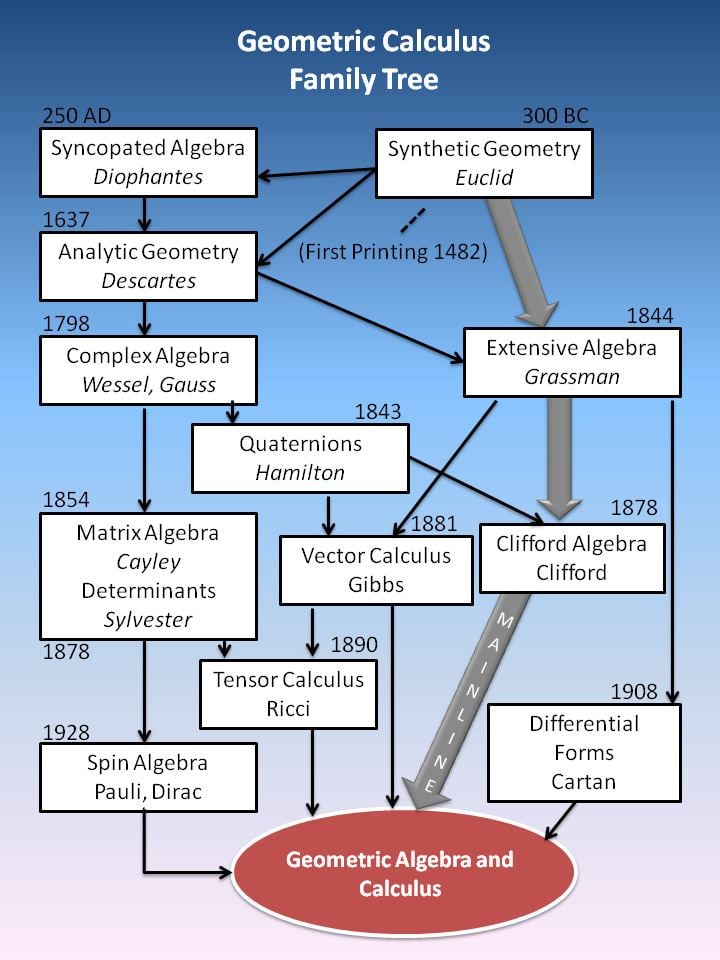 | ||
In mathematics, geometric calculus extends the geometric algebra to include differentiation and integration. The formalism is powerful and can be shown to encompass other mathematical theories including differential geometry and differential forms.
Contents
Differentiation
With a geometric algebra given, let a and b be vectors and let F(a) be a multivector-valued function. The directional derivative of F(a) along b is defined as
provided that the limit exists, where the limit is taken for scalar ε. This is similar to the usual definition of a directional derivative but extends it to functions that are not necessarily scalar-valued.
Next, choose a set of basis vectors
Then, using the Einstein summation notation, consider the operator :
which means:
or, more verbosely:
It can be shown that this operator is independent of the choice of frame, and can thus be used to define the geometric derivative:
This is similar to the usual definition of the gradient, but it, too, extends to functions that are not necessarily scalar-valued.
It can be shown that the directional derivative is linear regarding its direction, that is:
From this follows that the directional derivative is the inner product of its direction by the geometric derivative. All needs to be observed is that the direction
For this reason,
The standard order of operations for the geometric derivative is that it acts only on the function closest to its immediate right. Given two functions F and G, then for example we have
Product rule
Although the partial derivative exhibits a product rule, the geometric derivative only partially inherits this property. Consider two functions F and G:
Since the geometric product is not commutative with
then the product rule for the geometric derivative is
Interior and exterior derivative
Let F be an r-grade multivector. Then we can define an additional pair of operators, the interior and exterior derivatives,
In particular, if F is grade 1 (vector-valued function), then we can write
and identify the divergence and curl as
Note, however, that these two operators are considerably weaker than the geometric derivative counterpart for several reasons. Neither the interior derivative operator nor the exterior derivative operator is invertible.
Integration
Let
More generally, we may restrict ourselves to a subset of k of the basis vectors, where
Even more generally, we may consider a new set of vectors
The measure is therefore always proportional to the unit pseudoscalar of a k-dimensional subspace of the vector space. Compare the Riemannian volume form in the theory of differential forms. The integral is taken with respect to this measure:
More formally, consider some directed volume V of the subspace. We may divide this volume into a sum of simplices. Let
Fundamental theorem of geometric calculus
The reason for defining the geometric derivative and integral as above is that they allow a strong generalization of Stokes' theorem. Let
As an example, let
and likewise
Thus we recover the divergence theorem,
Covariant derivative
A sufficiently smooth k-surface in an n-dimensional space is deemed a manifold. To each point on the manifold, we may attach a k-blade B that is tangent to the manifold. Locally, B acts as a pseudoscalar of the k-dimensional space. This blade defines a projection of vectors onto the manifold:
Just as the geometric derivative
(Note: The right hand side of the above may not lie in the tangent space to the manifold. Therefore it is not the same as
If a is a vector tangent to the manifold, then indeed both the geometric derivative and intrinsic derivative give the same directional derivative:
Although this operation is perfectly valid, it is not always useful because
Since any general multivector can be expressed as a sum of a projection and a rejection, in this case
we introduce a new function, the shape tensor
where
Importantly, on a general manifold, the covariant derivative does not commute. In particular, the commutator is related to the shape tensor by
Clearly the term
Lastly, if F is of grade r, then we can define interior and exterior covariant derivatives as
and likewise for the intrinsic derivative.
Relation to differential geometry
On a manifold, locally we may assign a tangent surface spanned by a set of basis vectors
These relations embed the theory of differential geometry within geometric calculus.
Relation to differential forms
In a local coordinate system (x1, ..., xn), the coordinate differentials dx1, ..., dxn form a basic set of one-forms within the coordinate chart. Given a multi-index i1, ..., ik with 1 ≤ ip ≤ n for 1 ≤ p ≤ k, we can define a k-form
We can alternatively introduce a k-grade multivector A as
and a measure
Apart from a subtle difference in meaning for the exterior product with respect to differential forms versus the exterior product with respect to vectors (indeed one should note that in the former the increments are covectors, whereas in the latter they represent scalars), we see the correspondences of the differential form
its derivative
and its Hodge dual
embed the theory of differential forms within geometric calculus.
History
Following is a diagram summarizing the history of geometric calculus.
